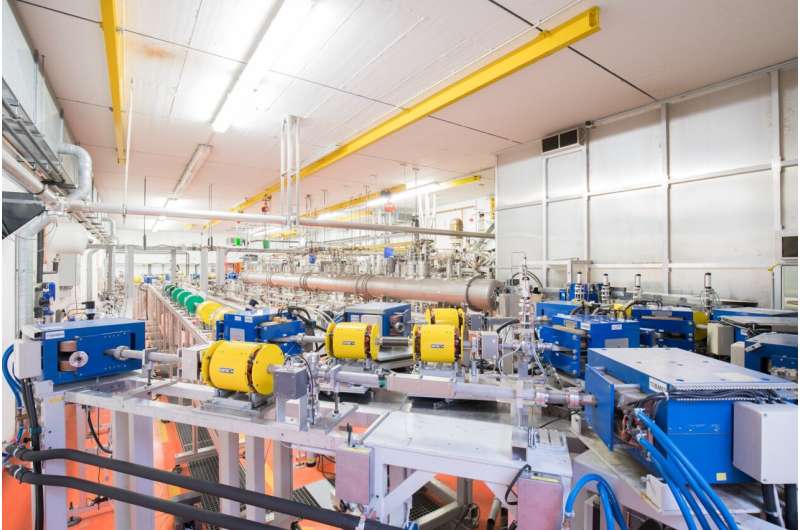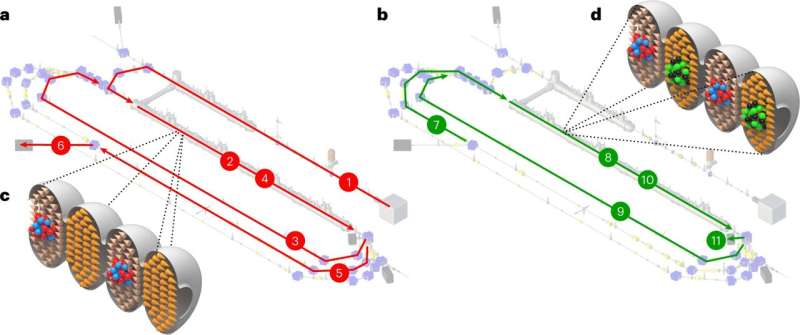
Particle accelerators are devices that use electromagnetic fields to speed up particles and collide them together or against a specific target. These devices are widely used by physicists to study particles, the forces that drive them and interactions between them.
The larger and most advanced particle accelerators in the world consume huge amounts of energy. In a paper published in Nature Physics, researchers at Technische Universität Darmstadt recently introduced a new measurement at their particle accelerator that can retain a high beam power while consuming significantly less energy.
“Particle accelerators are available in compact designs, such as those used for X-ray machines, and as large-scale facilities that are used for fundamental research,” Manuel Dutine, one of the researchers who carried out the study, told Phys.org. “The latter in particular consume an enormous amount of energy. This raises the question whether the added value justifies the realization of large research-accelerator facilities, especially from an economic and sustainable point of view.”
Future large-scale particle physics research will require accelerators with an increasingly high beam power. The key objective of the work by Dutine and his colleagues was to create an accelerator that could help to meet these needs while consuming less energy, using a technology known as energy recovery.
“The concept of energy recovery in particle accelerators is not new but under continuous development,” Dutine explained. “To achieve higher beam energies at reduced resource needs, the energy recovery concept should be combined with multi-turn acceleration, which was the purpose of our research.”

Accelerators accelerate beams, which are essentially a large set of particles, and this process unavoidably consumes energy. A high energy accelerated beam could collide with a resting target, another beam of particles or even laser light, potentially resulting in desired reactions that can then be studied. Reactions of interest, however, are very rare, and most particles in a beam end up not interacting with anything during an experiment.
“In a conventional accelerator, the remaining beam is dumped at high energy and the energy is wasted,” Dutine said. “In an ERL (energy recovery linac), the beam’s energy is recovered by decelerating the bunches. The energy is temporarily stored in the microwave fields in the accelerating structures and can afterwards be used to accelerate the next upcoming low-energy bunches.”
The ERL accelerator developed by Dutine and his colleagues has so far achieved very promising results. In initial tests, the team measured its energy recovery and recycling (i.e., the use of recovered energy for accelerating subsequent particle bunches) while accelerating an electron beam.
“By measuring energy savings, we demonstrated that the multi-turn energy recovery concept works,” Dutine said. “We measured a recovery of up to 87% of consumed beam power in the main accelerator. This power saving is financially relevant for beams with Gigawatt power or may help to reduce the footprint of energy consumption for large-scale facilities.”
The new multi-turn energy recovery accelerator created by this team of researchers could help to carry out physics studies more efficiently and sustainably, consuming less power while still achieving high beam energies. In the future, its unique design could inform the development of other accelerators with even lower fabrication costs and energy consumption, thus further promoting sustainable research. Dutine and his colleagues are now planning to upgrade their particle accelerator and also build a new one.
“The potential for energy saving is even larger for facilities with increased beam current, beam energies and number of turns,” Dutine added. “Here we are limited by the properties of our existing facility. We have started discussions with scientific partners, funding agencies, and our ministry to expand this research to a next-generation facility, in which we want to include our current findings, establish the energy recycling in a particle accelerator at larger scale, and thereby convince potential users from international science centers or industry to consider energy-recovering for their particle-accelerator needs.”
More information: Felix Schliessmann et al, Realization of a multi-turn energy recovery accelerator, Nature Physics (2023). DOI: 10.1038/s41567-022-01856-w.
Journal information: Nature Physics
© 2023 Science X Network

